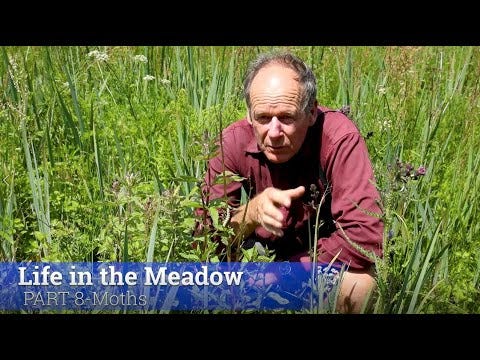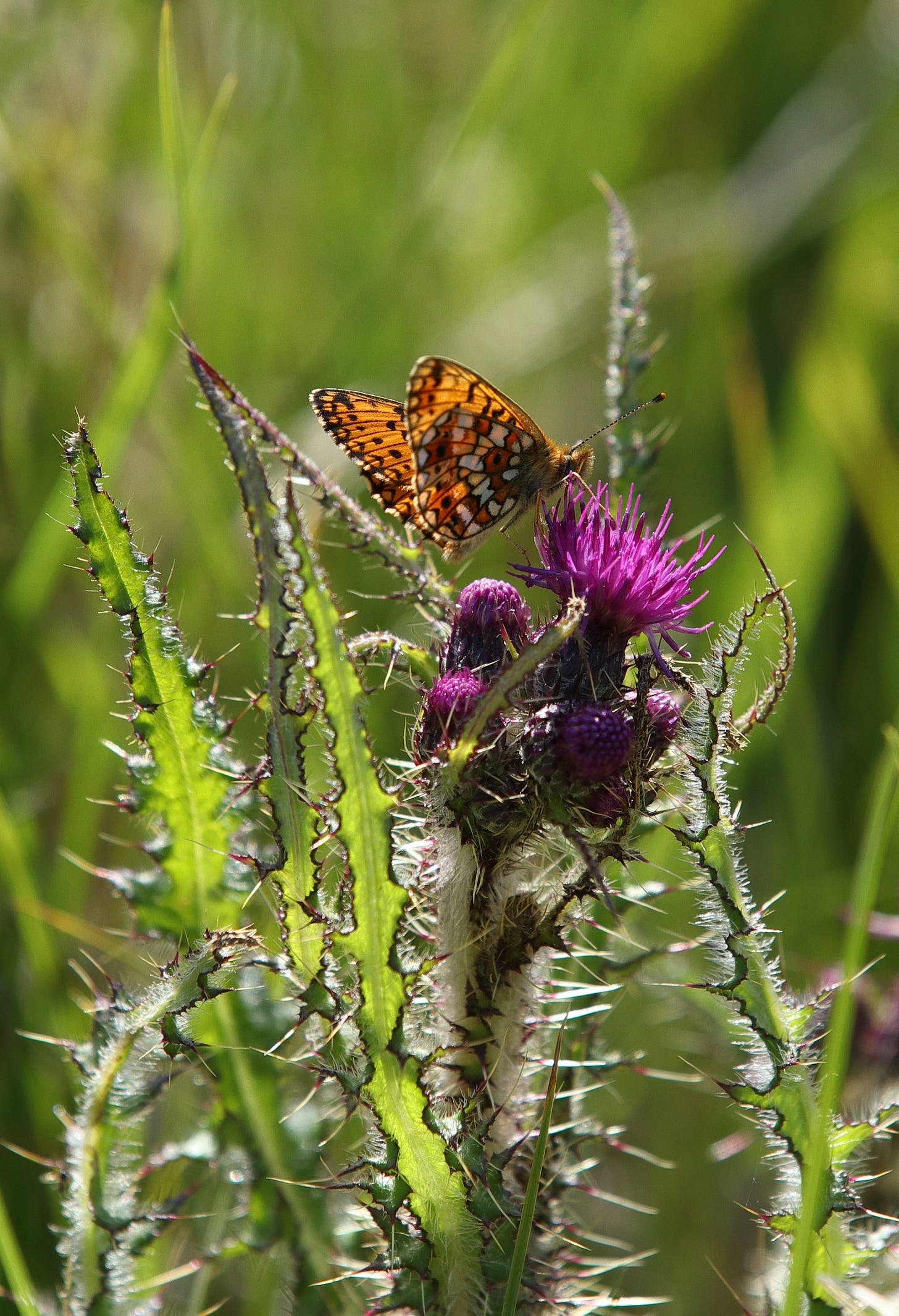Many of us have been doing the big butterfly count this year, which carries on next week and until 4th August - if you haven’t had a look yet - here is the link. It can be completed on an app - so very simple really.
I’ve been seeing far less butterflies this year, but since my no mow may - long grass lawn has been developing through the summer - I have seen far more moths!
I was flicking thorough the pages of Paul Kirkland’s great book - Discovering Scotlands Butterflies this week - brushing up on my butterfly ID ready for the big butterfly count, it has information on day flying moths as well. What’s the difference? Well….there isn’t a lot of difference from an observational level between the two. This great 4 minute video walks through some moths that you might come across in a meadow.
Moths, which make up a surprising 3% of all of Scotland's species, are a crucial part of the ecosystem. They serve as food for various mammals and birds and help with pollination. However, the distribution of species have been shifting, and many species are moving northward due to changes in the environment. There are over 2500 species of moths recorded in the British Isles - so the amateur doesn’t have a chance of identifying them all, but the UK moths website has 2283 illustrated so its a great place to start for those interested in moth ID and learning more about different species.
The Decline of Moth Populations
In recent decades, the UK has experienced a significant decline in biodiversity, and Scotland is no exception. Studies show that two-thirds of common and widespread macro-moth species in Great Britain have declined over a 40-year period, with an overall decrease in moth abundance by 28%.
Factors contributing to these changes include habitat loss, pollution, artificial light, and importantly climate change, both warming and changes in weather patterns. Moths are particularly sensitive to these environmental pressures, making them valuable indicators of ecological health.
Monitoring Moth Populations
Since the 1960s, moth recording in the UK has been well-developed in terms of data gathering, primarily through the Rothamsted Insect Survey (RIS) and the National Moth Recording Scheme (NMRS). Despite the extensive data collection, comprehensive trends for moth populations in Scotland have been lacking.
By monitoring Lepidoptera populations and distributions, scientists have gained some insights into broader environmental trends and the effectiveness of conservation efforts. The study by Fox et al. (2014) highlights that while some moth species restricted to northern Britain have declined, others that reached their northern range limit in southern Britain have increased. This mixed pattern of changes indicates a complex response to environmental pressures and shouts to the importance of data gathering to assist - particularly with range. As we are located in the most northerly part of Scotland any data gathered here would show if new species are entering the area.
The Northward Shift
As moths move north, they bring both positive and negative impacts on local ecosystems. The arrival of new moth and butterfly species could actually enhance the biodiversity of the Highlands and it is always exciting to see species you’ve not noted before entering your area'/garden. For example the Peacock butterfly has only been recorded in Highland in the last 25 years, though a relatively common sight these days. These new species arrivals introduce new pollination dynamics, potentially benefiting a variety of plants, and become food sources for local predators, thus enriching the food web.
However the opposite can also be the case. For example, plants that rely on specific moth and butterfly species for pollination are at risk if those Lepidoptera decline or are outcompeted by new species.
Its not just the range that is changing, the life cycle patterns are also shifting with some moths emerging later, and the species most likely to be able to thrive in varied climatic conditions being those that have more flexible life cycles (species plasticity), flight periods and number of generations per annum (Macgregor et al 2019).
Negative environmental changes in Scotland have further complicated the situation. Factors such as commercial afforestation, the deterioration of semi-natural grasslands and moorlands, increased deer grazing pressure, and the greater fragmentation and isolation of semi-natural habitats contributing to the challenges faced by moth populations.
Moreover, some moth species are known agricultural pests leading to use of pesticides and other control measures, which have further ecological repercussions.
The sensitivity of Lepidoptera to environmental changes makes them excellent indicators of ecological health. We know small changes to the environment can have big un-forseen impacts - “The Butterfly Effect”.

Conservation Strategies
The data collected by volunteer recorders such as those in the big butterfly count is invaluable in helping to track moth populations across the country, providing the data needed to identify trends and inform conservation strategies.
To mitigate the negative impacts of these changes, several strategies can be employed. Protecting and restoring natural habitats is crucial, as it provides refuges for both native and migrating moth species.
We have been working with volunteers and other conservation agencies such as Butterfly Conservation Trust - to focus on maintaining diverse and connected habitats such as meadows, butterfly banks and woodland edges within Highlands- these support a wide range of species, including our much loved butterflies and moths.
Reducing light pollution is another important strategy. Artificial light at night disrupts moth behaviour and can lead to population declines. Implementing measures to reduce light pollution, such as using motion-sensitive lighting and shielding lights to minimise their impact, can help protect nocturnal populations such as moths and bats.
Addressing the root causes of climate change is of course crucial. Reducing greenhouse gas emissions and promoting sustainable practices can help mitigate the effects of climate change on species and broader biodiversity. Additionally, sustainable farming practices, such as reducing pesticide use and maintaining hedgerows and wildflower margins, can support moth populations and other wildlife.
Moths are not just fascinating insects; they are vital components of our natural world. As we navigate the challenges of a changing climate, their movements offer valuable lessons and indicators of the health of our environment. By working together, scientists, policymakers, and the public can help safeguard the future of these important creatures and the ecosystems they inhabit. We all have an important role to play.
https://bigbutterflycount.butterfly-conservation.org/
Imogen Furlong, the High Life Highland Countryside Ranger Manager, is known for her enthusiasm, organisation, and drive. Her deep passion for the Scottish Highlands' wildlife and extensive experience in outdoor education and recreation management have been central to this role. Imogen is a practical and collaborative project manager, empowering her teams to work effectively in communities and contribute to local conservation efforts.
Read more about Moths and Butterflies on Nature Unveiled:












Speckled wood butterflies were unknown around our Perthshire village until a few years ago. There was great excitement when we started spotting them. Now they are quite a common sight.
I noticed a downturn in butterfly abundance in 2024 and think numbers were badly affected when we had terrific downpours - individuals would need excellent shelter to avoid being knocked down.